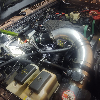2000StreetRod
Moderator Emeritus
- Joined
- May 26, 2009
- Messages
- 10,597
- Reaction score
- 334
- City, State
- Greenville, SC
- Year, Model & Trim Level
- 00 Sport FI, 03 Ltd V8
I bought a 2003 Aviator long block to install into a 2002 or 2003 Explorer that I hope to purchase in the future. See related thread: Next project vehicle? The Aviator was brought in to a tune-up shop because of a bottom end knock and the engine was swapped out to fix the knock. The mechanic who performed the swap is no longer employed at the shop so I have no details.
The engine is a modular Ford 4.6L DOHC V8 with four valves per cylinder.


The heads and block are identical to those used in the 2003 Mach 1. The stock Aviator intake system uses a single plate throttle body.

Since I have to purchase an intake system I decided to get one for a Mach 1 because it has a dual throttle plate oval intake.

I may use the included 24 lb/hr injectors which will require a custom tune since the stock Explorer PCM expects 19 lb/hr injectors. I intentionally purchased the Mach 1 intake system without fuel rails because they differ from the Aviator rails which has the fuel feed on the driver side and a pressure damper for each bank.

The engine is a modular Ford 4.6L DOHC V8 with four valves per cylinder.
The heads and block are identical to those used in the 2003 Mach 1. The stock Aviator intake system uses a single plate throttle body.
Since I have to purchase an intake system I decided to get one for a Mach 1 because it has a dual throttle plate oval intake.
I may use the included 24 lb/hr injectors which will require a custom tune since the stock Explorer PCM expects 19 lb/hr injectors. I intentionally purchased the Mach 1 intake system without fuel rails because they differ from the Aviator rails which has the fuel feed on the driver side and a pressure damper for each bank.










